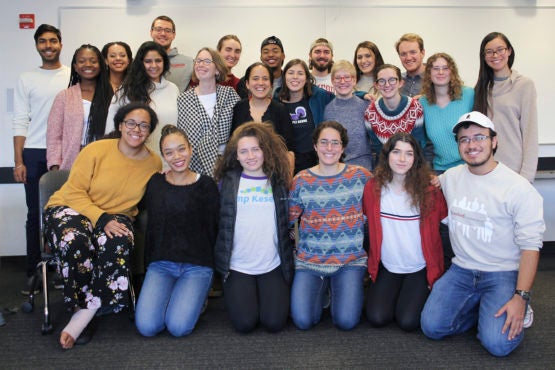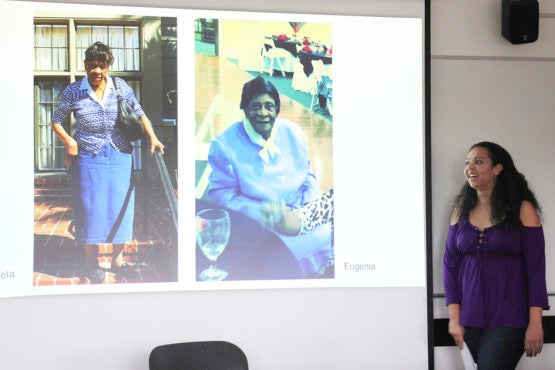New Stanford undergraduate class brings marginalized voices to the forefront of environmental science
In response to student interest and advocacy, the new course highlights issues at the intersection of environmental science and social justice.
Like many fields in academia, environmental science is lacking something important – voices from marginalized communities. That’s according to students who advocated for a new introductory course at Stanford attempting to address the problem. The class, Introduction to Environmental Justice, allows Stanford undergraduates to engage with difficult social justice issues from an environmental perspective in a safe space.

A new class allows Stanford undergraduates to engage with difficult social justice issues from an environmental perspective. (Image credit: Khuyen Nha Le)
Co-instructors Emily Polk, lecturer in the Program in Writing and Rhetoric, and Sibyl Diver, research scientist in Earth System Science, structured the class to give a microphone to voices that aren’t usually present in conversations about environmental issues. For Polk and Diver, bringing these voices to the center of the conversation was essential not only to teach students about concepts of environmental justice – the idea that climate change and environmental crises disproportionately affect the lives of marginalized people – but also to teach them how to write and communicate those concepts.
“This is a class about environmental justice, but it’s also a model for the justice we’re learning about and seeking,” Polk said. “Our students may enter the class without a background in EJ scholarship, but they understand that the theories and histories behind it are crucial to know and communicate effectively in order to be able to meet the social and environmental challenges of our time.”
Centering marginalized voices
For Polk and Diver, there’s a lot to learn from listening to people who aren’t traditionally a part of environmentalism, like communities of color, women, queer-identifying individuals and other traditionally marginalized groups.

Stephanie Fischer, shown making her presentation in class, is a senior double majoring in Earth systems and music composition. (Image credit: Khuyen Nha Le)
“Marginalized communities have always faced the brunt of climate change and environmental crises,” Polk explained. “They’ve had to come up with solutions long before the problem was even visible to mainstream people.”
To bring these voices into the conversation, Polk and Diver invited guest lecturers each week to talk about concepts in environmental justice like “afrofuturism,” the idea that science fiction can help us imagine a future in which climate issues don’t disproportionately affect communities of color. In fact, they reached out to so many guest lecturers – and received so many enthusiastic yeses – that they decided to host an environmental justice symposium at Stanford this year.
As students were exposed to different perspectives, Polk and Diver also asked them to consider how their identities influence the way they approach environmental problems and social justice issues, a concept called positionality.
“We need to be aware of our positionality: what it allows us to see and what it prevents us from seeing,” Diver said.
A new classroom dynamic
The class was capped at 20 students to create a safe, intimate space for students to listen and discuss hard issues in environmental justice. “This class has been a very different dynamic than what I’m used to, but in the best possible way,” said Juliana Berglund-Brown, a sophomore civil and environmental engineering major who is currently in the class.
For the class, the students developed and wrote a research project to explore an issue in environmental justice. Then they strategized how to communicate their findings to maximize the impact of their project. Projects range from writing op-eds and drafting proposals to recording podcasts and making documentaries.
For her project, Whitney Francis, a senior majoring in Earth systems, is writing a proposal for Stanford to include more environmental justice programs. “After taking this class I’ve seen how important it is for students, as future leaders of the world, to be aware of these environmental justice issues and their own positionality,” she said.
By student demand
The class came about through advocacy by students across the Stanford campus. One alumnus, Paloma Hernandez of the class of 2018, surveyed 357 Stanford undergraduates about environmental justice and their interest in an environmental justice class at Stanford as part of her capstone project.
Her survey showed that Stanford students had vastly different understandings of what “environmental justice” means. It also showed that they had a strong interest in learning more and many felt that the human aspect of environmental issues was lacking in their education.
“That the class exists is such a victory,” said Mehr Kumar, undergraduate course assistant and a junior double majoring in Earth systems and feminist, gender, and sexuality studies.
Stephanie Fischer, a senior double majoring in Earth systems and music composition, echoed that sentiment. “I hope this class continues, but I also hope that more environmental justice classes spring up because of this – hopefully creating an entire curriculum.”
